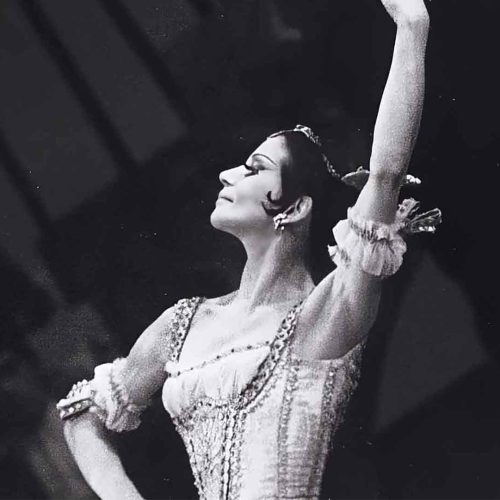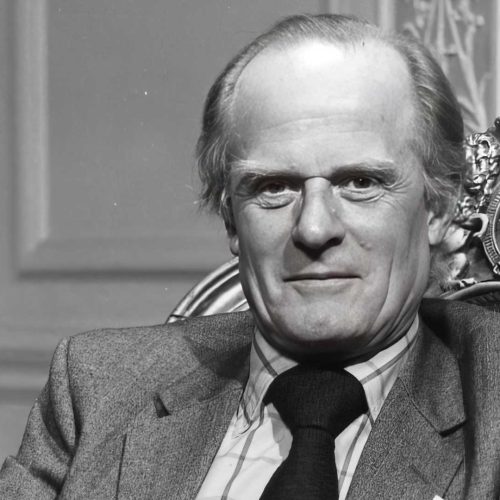By Julian Mitchell, playwright
Many ballets adapt themes and short stories from other media. But the challenges and problems of adaptation are not confined to ballet.
Adapt or die is a rule of life. Of art, too. We can’t go on and on with the same version of the same old stories. There are, as any creative writing teacher will tell you, only a very limited number of plots, and we need them to keep coming up fresh. Many of them seem to have originated with Homer – but surely he didn’t invent all those gods and goddesses and Trojans and Greeks, he was just the first person to write them down, no doubt improving them as he thought fit – adapting them, in fact – from unwritten epics and legends. It’s the same with Adam and Eve ; the author of Genesis can hardly have made them up out of nothing. Did Shakespeare ever have an original idea ? One, perhaps. Scholars think most of The Merry Wives of Windsor is his own invention, but not the laundry basket, and Falstaff, of course, he adapted from his own earlier work, at the request of the Queen. Hamlet, Henry IV, Lear – all the great plays had their origin in something he’d read. Originality as such is rare in the arts, though it does happen: a recent example might be the invention of abstract painting which switched attention from the subject of a picture to the way it was painted, and modern dance can have movement without a specific subject. But most art requires some form of comprehensible narrative, and in drama it’s essential, or people simply won’t come.
Many adaptations go on to be adapted themselves, so that the story of Odysseus (or Ulysses) trying to get back to his wife in Greece after the Trojan War has been reverberating through European literature for three thousand years or more, and specially, it seems, in the last hundred years in English literature as James Joyce and other “modernists” have followed Ezra Pound’s advice to “make it new”. New translations and adaptations – and translation is always a form of adaptation – appear every year. Unfortunately for Pound, not all adaptations are worth adapting. Although he embarked on his Cantos with a parody of Odysseus setting out from Troy, he soon lost touch with the story and his poem became exceedingly and at times impenetrably obscure, so it’s hard to imagine anyone wanting to adapt it for stage or screen or ballet. Many other versions are the end of a line. Made for a particular time and place they stay there, which doesn’t mean they were bad. But the great original goes on and on being adapted.
The novel seems from time to time to free itself from the need for narrative. There is Finnegan’s Wake, for instance, which may have a story, but if so few have persisted long enough to find it. And there’s a French novel without the letter “e”, which has been similarly left unfinished, though for all I know it may have a vry xciting tal to tll. I like a good story myself and feel most of the world is with me. But it is not always easy to see the fundamental story behind new ways of telling it. At the first London production of Waiting for Godot in 1955, I, like many people, was bewildered ; but I felt there was something going on in the play which I really wanted to understand. I don’t pretend I fully understand it even now, when it’s recognised as a great work, produced everywhere all the time, and presenting little difficulty. It’s even been shown on television, though it seems to me essentially theatrical ; perhaps it was simply a film of a stage production ? Is it, perhaps, unadaptable ? Is anything ?
There’s a new ballet based on Arthur Miller’s The Crucible, which has a very strong seventeenth century story, based on a something that actually happened. But Miller was writing it as a metaphor for the careless accusations of communism thrown about by Joseph McCarthy in 1950s America, and I don’t know how the choreographer has been able to indicate that. Of course no one goes to the ballet for political history, and if the new ballet works in its own artistic terms, that’s all we need ask. This one is a good example of an adaptation of an adaptation – the old story has taken on a new form. Whether it will last long enough to be adapted itself only time, which adapts all things, can tell.
The first time I saw Uncle Vanya it was in English and Sybil Thorndike came on in a head scarf pretending to be a Russian peasant woman feeding her chickens, and though I could see there was a magnificent play hiding behind the translation, I knew I wasn’t getting anything like the real thing in a production full of British knights and dames. The trouble, I now see, was that nothing had been translated but the dialogue. This was partly out of respect for a great playwright, I’m sure, but respect had gone too far. We’re never going to get an authentic Russia on a British stage with British actors and audience. But we can and should translate more than dialogue. The names, to start with; what is more off-putting than the Russian ones ? Then the place. We can move everything from Russia to wherever feels most suitably British. (Three Sisters makes perfect sense reimagined in British India, by the way.) In fact we can anglicise the whole thing, so the cherry orchard becomes an apple one in Herefordshire, say, and Uncle Vanya a Yorkshire land agent, or – when I got the opportunity to put my theory into practice – a Welshman in Gwynnedd. I can’t speak or read Russian, so I depended on a Russian friend’s translation of the text and set it as far from London as I imagine Moscow was in the original. (I don’t speak or read Welsh either, but the Welsh gentry of Vanya’s time would all have spoken English.) With a Welshman in the lead, we made Vanya new for a particular audience in a particular theatre. It was, I like to think, what an adaptation should be. Not everyone agreed, and what Chekhov would have thought I’ve no idea. A Russian might well think any form of adapted Chekhov is sacrilege. But it’s astonishing how fresh a foreign play can seem when the attempt to be French or Italian or Russian is abandoned.
I don’t say that British versions which stick to the original setting are necessarily somehow wrong ; just that they may, paradoxically, be less faithful to the original than a complete adaptation. But what does “faithful” in this context mean ? Getting to the heart of the play, showing its universal appeal ? Well, if it does do those things, if indeed they are doable, then good luck. But there are no rules in the theatre, so long as the result is artistically satisfying. And what do I mean by that ? Sorry, I don’t have time, I’m adapting Jane Austen now.
Austen raises the issue of fidelity acutely. She’s British to start with (almost intolerably so, some say) and very popular, so the settings and characters have to be kept pretty much as they are in the books or people will complain. Americans and Russians have greater freedom, but if you’re doing Pride and Prejudice for an English audience, it will expect the early 1800s, muslin dresses and Mr Darcy to marry Elizabeth. But novels are much longer than plays, there have to be cuts, sometimes of whole scenes and characters. And a novel has its own rhythm, which is not the same as the rhythm of a stage play or a television series. You can put it down and pick it up again over several days, its pace is often leisurely. But leisureliness in the theatre is death at the box office and the audience expects to be continuously entertained for two or three hours with only one or two short breaks. Then there is the problem of where to set the play. Austen’s characters don’t stick to their rented rooms in Bath, they’re for ever off to the Pump Room or taking country walks. They sometimes go wandering off to distant and wholly unstageable places like the Cobb in Lyme Regis. Which is fine for television or film, but when someone falls on the Cobb, the information has to be conveyed on stage in a scene Austen failed – how unhelpful ! – to write. Whereupon a new problem arises.
The dialogue in Austen’s novels is much more stylised than in life – she wrote to be read aloud – and the formality can seem dreadfully unreal on stage, and particularly so on film. A new kind of language is needed which sounds like Austen but is more realistic while avoiding grating modernisms. “A neutral tone is nowadays preferred”, wrote Donald Davie, not referring to adaptations but 1950s poetry, but it’s a good tip for non-contemporary dialogue. But it mustn’t be too neutral, it must still keep a sense of another time and place. Austen looks easy to adapt at first – strong characters, elegant settings, good stories ; but – pish and tush – she’s not.
Television Austen is easier than stage. You can spin your adaptation over several evenings, so cuts may not be so necessary, and with a sufficient budget you can go to Bath and Lyme Regis. But you may have to jiggle the story to find suitable climaxes for each episode, and the problem of dialogue remains because so much in film is conveyed by looks rather than words. The question of length arises here too, and the difference between ITV and the BBC. Up to ninety unbroken minutes requires a different structure and rhythm from ninety minutes with commercial breaks. Some people dislike breaks on principle and my own father actually walked out of the room when one came on in something I’d adapted, so adamant was he against them. I often find commercials very irritating myself, especially during cricket, but for an adapter they can come at just the right moment and act like the curtains between acts in the theatre. They also give the opportunity for a regular series of climaxes.
TV has one problem, very much its own. It’s so time-bound, with the News having to be at Six and Ten except at times of national crisis, and there’s an hour before which children may be watching so there must be no graphic sex or heavy swearing – though there seems to have been some relaxation of this recently in acknowledgement of the fact that children now swear more than adults. In the days of the single play – when, people sigh nostalgically, the nation spoke to itself uninterrupted through the Wednesday Play or Play for Today – there was still a time limit imposed by the national bladder, as there is in the cinema, except when dictatorial directors demand uninterrupted attention for three hours and more, and the audience is constantly distracted by people getting up and going to and coming back from the loo. Sensible cinema managers ignore the tyrannical director and put in a short break halfway through. They adapt, in fact, to reality. As we all must in the end.



